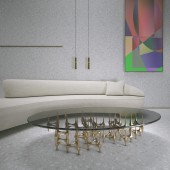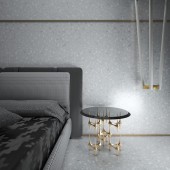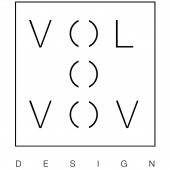Project Tripod Table base by Pavel Volovov |
Home > Winners > #59345 |
 |
|
||||
| DESIGN DETAILS | |||||
| DESIGN NAME: Project Tripod PRIMARY FUNCTION: Table base INSPIRATION: The Tripods concept originated from the Great Coral Reef where one can espy the ineffable beauty that is created by colonies of polyps working meticulously together. This project aimed to diminish the sharp contrast between a micro and macro scale by allowing for final creations to be made on a macro scale, while simultaneously devoting a large aspect of design to the micro aspect of the individual Tripods. The lines and design of individual components were greatly influenced by the way that light undulates throughout the Great Coral Reef, as it is what gives life to the whole structure by allowing all animals to thrive and giving the Coral Reef color. Furthermore, the shape of the Tripod was then designed by creating a hybrid that blended elements of modern architectural styles and has integrated fluid and organic lines into the core of the design with aspects that occur in nature. Lastly, the addition of assemblage of the final product by the customer was inspired by the mutualistic relationship between polyps and algae that allows for the Coral Reef to be grand, similarly in the Tripods project a relationship is created between the purchaser and the product in the assembly, as it allows for a great creation to occur by combining the design of Tripods with creative elements of the customer. UNIQUE PROPERTIES / PROJECT DESCRIPTION: The Tripod is a sculpture unlike any other, with bionic shapes made of brass and 3 pillars that fluidly connect. It is designed to be assembled one with another. The sculpture of Tripod itself is created to satisfy aesthetic demands of customers, but simultaneously gives the possibility for the customer to become a co-creator in the final product, evincing creative aspects of the customer. Thus, the process of assembling becomes an adventure, rather than a chore and can yield amazing results. OPERATION / FLOW / INTERACTION: The product has been envisioned to be sold as a single unit, as a collectible design piece, or in a set through which one can craft a side table, a dining table, a low table, or a console. The main goal of the product is for the customer to assemble the product themselves allowing for no two creations to be the same, the experience not to be vapid, and allow all customers to evince their own artistic qualities in the final product. PROJECT DURATION AND LOCATION: The project originated in Moscow in 2014 and has been in development. FITS BEST INTO CATEGORY: Furniture Design |
PRODUCTION / REALIZATION TECHNOLOGY: Tripods are made using a high-pressure brass casting and hand polishing process that allows for them to be of impeccable quality. Final assembly of Tripods does not have a guided manner as it is at the will of the customer to assemble the Tripods, through which they can vehemently display their artistic qualities. Lastly, for the tops of the furniture pieces, the material used is tempered glass. SPECIFICATIONS / TECHNICAL PROPERTIES: The single sculpture dimensions (mm) - 190L 190P 190h. The package contains 3 units. TAGS: table, dining, console, bedside, brass, casting RESEARCH ABSTRACT: The primary research showed that the furniture market has no similar products. Thanks to possibility of customer involvement to the creative process, the product offers variety of combinations to achieve the unique results. Qualitative research methodology gave the impression that potential clients are interested in development of Tripod CHALLENGE: The portion that was most challenging for us to overcome was the creation and development of the shape of Tripods so that it could adhere to the dimensions and height of the dining table, console, low table, and side table. Furthermore, from a social perspective, this project was and will be seen as unorthodox, as it takes a new approach to furniture design by changing the notion from store-bought furniture to an alternative with which a customer can design and alter furniture to their liking. ADDED DATE: 2017-08-06 15:17:21 TEAM MEMBERS (1) : Designer: Pavel Volovov IMAGE CREDITS: Pavel Volovov, 2017. |
||||
| Visit the following page to learn more: http://www.volovov.design | |||||
| AWARD DETAILS | |
 |
Project Tripod Table Base by Pavel Volovov is Winner in Furniture Design Category, 2017 - 2018.· Press Members: Login or Register to request an exclusive interview with Pavel Volovov. · Click here to register inorder to view the profile and other works by Pavel Volovov. |
| SOCIAL |
| + Add to Likes / Favorites | Send to My Email | Comment | Testimonials | View Press-Release | Press Kit |







